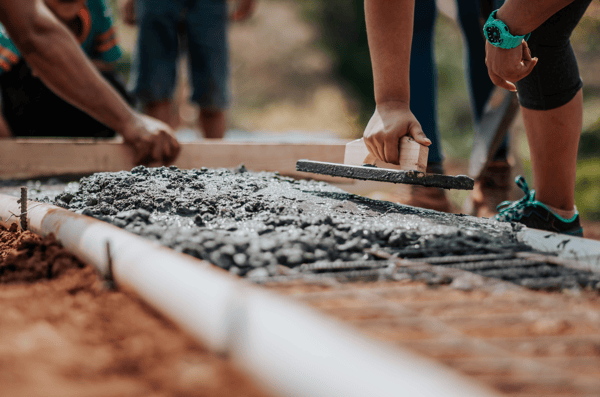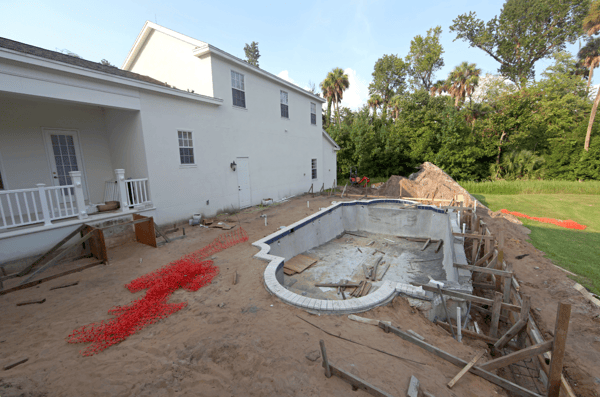You DIY pretty much everything else in your life, why not DIY your own concrete pool?
If that sounds like the conversation you just had with yourself, you've come to the right place. Here's what you need to know: making your own concrete pool is not the right move for a novice DIY'er.
But if you know your way around some big machinery and aren't afraid of some elbow grease, pouring your own pool may be the right move for you.
Read below to learn more.
What Are the Pros and Cons of a Concrete Pool As Opposed to the Other Types?
Well, let's address the elephant in the room first, cost. Concrete pools are some of the most expensive to pour, whether you DIY or not. They're more expensive to chlorinate, given that the concrete is porous, even after sealing, and they use more electricity.
But there are benefits too! You can make more and deeper shapes with a concrete pool than with a fiberglass or vinyl liner option. Concrete pools are more durable in the long run, standing up to more wear and tear, along with inclement weather.
Finally, some people think that concrete pools just look better than other options and they're a good fit for someone who wants to customize every aspect of their pool-build experience.


What You'll Need to Build a Concrete Pool
When it comes to the tools you need to pour a concrete pool, you should rent the large-scale ones, and buy the rest. At some point in the pool's life you will need to resurface and repair the inside, so keeping your concrete tools on hand is the best bet!
In the long run, you'll need:
- Something to excavate, like a backhoe
- Steel bars, ties, plywood
- Plumbing pipes, pumps, and accessories
- Concrete for pouring/spraying
- Grinders for smoothing
- Sealants
- Tile for coping and patio
- Plaster
- Any other finishes
- Cleaning supplies
- Water source
You can find much of the machinery you need for the concrete steps here.
Most other supplies are available at your local home improvement store. You may be able to rent a backhoe from there as well, to dig the pool shell.
Steps to Creating a Concrete Pool
This is not a definitive guide, as creating a concrete pool is a complex process. It will, however, give you a good idea of the steps and the timeline for your impending build.
Step 1: Design and Plan
Before you start digging, you need to map out where your pool will be, gather the appropriate permits, buy all the necessary materials, and prep the area of your pour.
Step 2: Rent a Backhoe and Get to Digging!
The second step may be the most fun if you like playing with heavy machinery. You can either hire a local contractor to dig out your pool site or rent the backhoe and do it yourself.
You'll also need to consider a truck to haul off the excess dirt and figure out where you can dump it.
Step 3: Time for Rebar!
This may be the most labor-intensive part of the process, depending on how used to working with steel you are. You'll need to make a steel grid for every square foot you'd like your pool to cover. That includes up the walls and on any stairs.
When shopping for supplies buy more rebar than you think you'll need and think about the tools needed to cut and bend the steel into shape.
This step can take up to 3-4 days, depending on how fast you work.
Step 4: Add Plumbing
Once you have your rebar installed, you'll need to put in the plumbing system your pool will use. Talk to your local plumber or consult your pool plan for which pipes need to go under (before) the rebar and which need to go in after.
Installing the plumbing, capping, and pressure testing it should take 2-3 days.
In most cities, you'll need to call your local inspector and have them come check your work before you move on to the next step.
Step 5: The Concrete Shell
Once the plumbing has been tested and approved, it's time to spray the concrete in place. This involves a lot of heavy mixed material, special spraying equipment, and a lot of messy hard work.
Along with the concrete, spraying equipment, and personal protective gear - you'll also need tools to mold and spread the concrete to keep it from gathering.
This process takes up to two days, depending on the size of the pool.
Step 6: Wait!
After the concrete is poured, it'll need to "cure" for around thirty days. If you rush it, it'll damage the quality of your results. During that time you'll need to spray the surface of the concrete down every two to three days with your hose.
This is a great time to start working on your patio, deciding if what kind you want to pour and if you're going to seal the concrete, stain it, or stamp in a pattern.
Step 7: Waterproofing and Plastering
Once the concrete is cured, you'll need to grind down the rough areas and then seal it with a waterproofing solution. When that's all dry, you can begin to add the plaster that will serve as the lining of the pool.
This step can take 3-7 days.
Step 8: Fill the Pool
Once all that is done, everything is dry, and all the plumbing is sealed correctly, it's time to treat your water and start filling the pool!
The final timeframe for this product is around 15 weeks - but then you have your pool for a lifetime!

Where to Buy Concrete Pool Supplies
While you'll need to get rebar and pipes from your local stores, we can help you with your machinery and tool needs for your concrete pool build.
If you have any questions, feel free to give us a call! You can browse all our available tools and machinery, here.

1 Comment